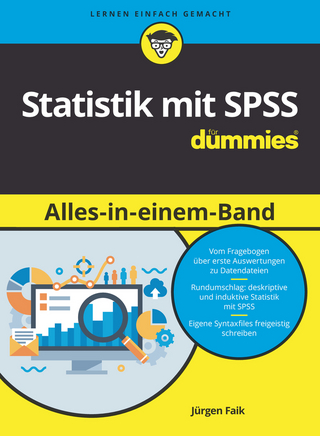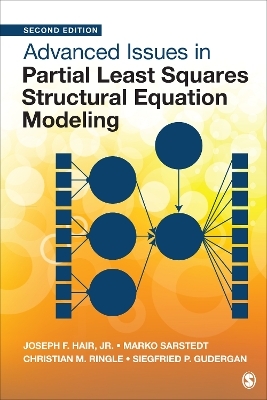
Statistics
John Wiley & Sons Inc (Verlag)
978-1-118-94109-6 (ISBN)
"...I know of no better book of its kind..." (Journal of the Royal Statistical Society, Vol 169 (1), January 2006)
A revised and updated edition of this bestselling introductory textbook to statistical analysis using the leading free software package R
This new edition of a bestselling title offers a concise introduction to a broad array of statistical methods, at a level that is elementary enough to appeal to a wide range of disciplines. Step-by-step instructions help the non-statistician to fully understand the methodology. The book covers the full range of statistical techniques likely to be needed to analyse the data from research projects, including elementary material like t--tests and chi--squared tests, intermediate methods like regression and analysis of variance, and more advanced techniques like generalized linear modelling.
Includes numerous worked examples and exercises within each chapter.
Michael J. Crawley, FRS, Department of Biological Sciences, Imperial College of Science, Technology and Medicine. Author of three bestselling Wiley statistics titles and five life science books.
Preface xi
Chapter 1 Fundamentals 1
Everything Varies 2
Significance 3
Good and Bad Hypotheses 3
Null Hypotheses 3
p Values 3
Interpretation 4
Model Choice 4
Statistical Modelling 5
Maximum Likelihood 6
Experimental Design 7
The Principle of Parsimony (Occam’s Razor) 8
Observation, Theory and Experiment 8
Controls 8
Replication: It’s the ns that Justify the Means 8
How Many Replicates? 9
Power 9
Randomization 10
Strong Inference 14
Weak Inference 14
How Long to Go On? 14
Pseudoreplication 15
Initial Conditions 16
Orthogonal Designs and Non-Orthogonal Observational Data 16
Aliasing 16
Multiple Comparisons 17
Summary of Statistical Models in R 18
Organizing Your Work 19
Housekeeping within R 20
References 22
Further Reading 22
Chapter 2 Dataframes 23
Selecting Parts of a Dataframe: Subscripts 26
Sorting 27
Summarizing the Content of Dataframes 29
Summarizing by Explanatory Variables 30
First Things First: Get to Know Your Data 31
Relationships 34
Looking for Interactions between Continuous Variables 36
Graphics to Help with Multiple Regression 39
Interactions Involving Categorical Variables 39
Further Reading 41
Chapter 3 Central Tendency 42
Further Reading 49
Chapter 4 Variance 50
Degrees of Freedom 53
Variance 53
Variance: A Worked Example 55
Variance and Sample Size 58
Using Variance 59
A Measure of Unreliability 60
Confidence Intervals 61
Bootstrap 62
Non-constant Variance: Heteroscedasticity 65
Further Reading 65
Chapter 5 Single Samples 66
Data Summary in the One-Sample Case 66
The Normal Distribution 70
Calculations Using z of the Normal Distribution 76
Plots for Testing Normality of Single Samples 79
Inference in the One-Sample Case 81
Bootstrap in Hypothesis Testing with Single Samples 81
Student’s t Distribution 82
Higher-Order Moments of a Distribution 83
Skew 84
Kurtosis 86
Reference 87
Further Reading 87
Chapter 6 Two Samples 88
Comparing Two Variances 88
Comparing Two Means 90
Student’s t Test 91
Wilcoxon Rank-Sum Test 95
Tests on Paired Samples 97
The Binomial Test 98
Binomial Tests to Compare Two Proportions 100
Chi-Squared Contingency Tables 100
Fisher’s Exact Test 105
Correlation and Covariance 108
Correlation and the Variance of Differences between Variables 110
Scale-Dependent Correlations 112
Reference 113
Further Reading 113
Chapter 7 Regression 114
Linear Regression 116
Linear Regression in R 117
Calculations Involved in Linear Regression 122
Partitioning Sums of Squares in Regression: SSY = SSR + SSE 125
Measuring the Degree of Fit, r 2 133
Model Checking 134
Transformation 135
Polynomial Regression 140
Non-Linear Regression 142
Generalized Additive Models 146
Influence 148
Further Reading 149
Chapter 8 Analysis of Variance 150
One-Way ANOVA 150
Shortcut Formulas 157
Effect Sizes 159
Plots for Interpreting One-Way ANOVA 162
Factorial Experiments 168
Pseudoreplication: Nested Designs and Split Plots 173
Split-Plot Experiments 174
Random Effects and Nested Designs 176
Fixed or Random Effects? 177
Removing the Pseudoreplication 178
Analysis of Longitudinal Data 178
Derived Variable Analysis 179
Dealing with Pseudoreplication 179
Variance Components Analysis (VCA) 183
References 184
Further Reading 184
Chapter 9 Analysis of Covariance 185
Further Reading 192
Chapter 10 Multiple Regression 193
The Steps Involved in Model Simplification 195
Caveats 196
Order of Deletion 196
Carrying Out a Multiple Regression 197
A Trickier Example 203
Further Reading 211
Chapter 11 Contrasts 212
Contrast Coefficients 213
An Example of Contrasts in R 214
A Priori Contrasts 215
Treatment Contrasts 216
Model Simplification by Stepwise Deletion 218
Contrast Sums of Squares by Hand 222
The Three Kinds of Contrasts Compared 224
Reference 225
Further Reading 225
Chapter 12 Other Response Variables 226
Introduction to Generalized Linear Models 228
The Error Structure 229
The Linear Predictor 229
Fitted Values 230
A General Measure of Variability 230
The Link Function 231
Canonical Link Functions 232
Akaike’s Information Criterion (AIC) as a Measure of the Fit of a Model 233
Further Reading 233
Chapter 13 Count Data 234
A Regression with Poisson Errors 234
Analysis of Deviance with Count Data 237
The Danger of Contingency Tables 244
Analysis of Covariance with Count Data 247
Frequency Distributions 250
Further Reading 255
Chapter 14 Proportion Data 256
Analyses of Data on One and Two Proportions 257
Averages of Proportions 257
Count Data on Proportions 257
Odds 259
Overdispersion and Hypothesis Testing 260
Applications 261
Logistic Regression with Binomial Errors 261
Proportion Data with Categorical Explanatory Variables 264
Analysis of Covariance with Binomial Data 269
Further Reading 272
Chapter 15 Binary Response Variable 273
Incidence Functions 275
ANCOVA with a Binary Response Variable 279
Further Reading 284
Chapter 16 Death and Failure Data 285
Survival Analysis with Censoring 287
Further Reading 290
Appendix Essentials of the R Language 291
R as a Calculator 291
Built-in Functions 292
Numbers with Exponents 294
Modulo and Integer Quotients 294
Assignment 295
Rounding 295
Infinity and Things that Are Not a Number (NaN) 296
Missing Values (NA) 297
Operators 298
Creating a Vector 298
Named Elements within Vectors 299
Vector Functions 299
Summary Information from Vectors by Groups 300
Subscripts and Indices 301
Working with Vectors and Logical Subscripts 301
Addresses within Vectors 304
Trimming Vectors Using Negative Subscripts 304
Logical Arithmetic 305
Repeats 305
Generate Factor Levels 306
Generating Regular Sequences of Numbers 306
Matrices 307
Character Strings 309
Writing Functions in R 310
Arithmetic Mean of a Single Sample 310
Median of a Single Sample 310
Loops and Repeats 311
The ifelse Function 312
Evaluating Functions with apply 312
Testing for Equality 313
Testing and Coercing in R 314
Dates and Times in R 315
Calculations with Dates and Times 319
Understanding the Structure of an R Object Using str 320
Reference 322
Further Reading 322
Index 323
| Verlagsort | New York |
|---|---|
| Sprache | englisch |
| Maße | 168 x 239 mm |
| Gewicht | 680 g |
| Themenwelt | Mathematik / Informatik ► Mathematik ► Computerprogramme / Computeralgebra |
| Mathematik / Informatik ► Mathematik ► Statistik | |
| Mathematik / Informatik ► Mathematik ► Wahrscheinlichkeit / Kombinatorik | |
| ISBN-10 | 1-118-94109-8 / 1118941098 |
| ISBN-13 | 978-1-118-94109-6 / 9781118941096 |
| Zustand | Neuware |
| Informationen gemäß Produktsicherheitsverordnung (GPSR) | |
| Haben Sie eine Frage zum Produkt? |
aus dem Bereich


